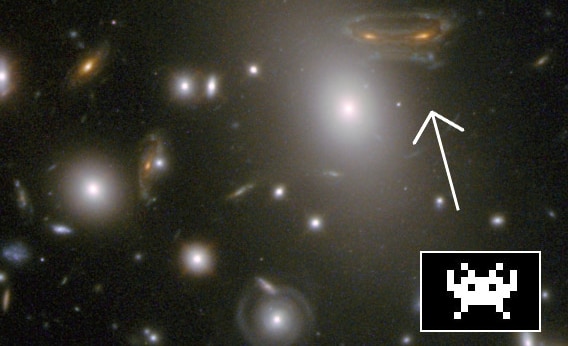Create a free profile to get unlimited access to exclusive videos, sweepstakes, and more!
Hubble Spies a Space Invader

Well, thatâs it. Now Iâve seen everything.
Hubble has spotted a galaxy shaped like one of the aliens from the game âSpace Invadersâ.
I have to admit, itâs a good resemblance. I love how the galaxy itself looks more sinister than the 8-bit game character. If I had been in charge of this Hubble observation, I probably wouldâve wet myself laughing.
But this is more than just a geek gaming icon. Thereâs real science here, and itâs very cool.
This is an example of gravitational lensing. A lens works by bending light, changing the path that light follows, bringing the light to a focus. If the lens itself is distorted, the resulting image too can be distorted (like looking at something across your room through a soda bottle).
Gravity can do the same thing. If you have a massive objectâsay, a cluster of galaxies, each containing billions of starsâthen light from a more distant galaxy passing it will have its path bent. This can create distorted and even multiple images of that more distant galaxy.
Think of it this way: Imagine me sitting on a flat floor, rolling marbles away from me in all directions. If youâre sitting a few meters away, you can only catch the marbles that are aimed at you. But if thereâs a dip in the floor between us, some of the marbles I roll that might have otherwise passed you to the right, say, will get their path diverted to the left a bit, more toward you, as they curve around the dip. Those would have missed you without the dip, but because they get bent you can catch them. The same thing happens if a marble is sent off to the left, and gets diverted a little to the right.
In the real Universe, I am a distant galaxy, you are Hubble, marbles are light, and that dip is the combined mass of thousands of billions of stars in hundreds of galaxies.
In this case, Hubble was observing the galaxy cluster Abell 68, a massive collection of galaxies about three billion light years away. Thatâs pretty far, but there are many galaxies farther yet. We see those more distant galaxies all around the cluster, and some right through it. Their light gets distorted, and boom. Weird, smeared gravitational lenses. The Space Invader galaxy is actually a spiral that had its image duplicated, with one reversed, and squished together. You can see the original galaxy on the left in the picture above (marked with an arrow). You can actually trace the spiral arms, and even see clumps and knots in the arms where there are giant gas clouds forming stars.
This sort of lensing isnât unheard of, but due to the physics itâs far more common to see the galaxies stretched out into long, graceful arcs by the lensing effect. In the full Hubble image of Abell 68 you see arcs all over the place. Hereâs a video tour of the cluster image, and you can see quite a few:
See? You should really grab the full-resolution image of the cluster; itâs quite beautiful and contains hundreds of galaxies of all shapes and sizes.
In fact, there was one such galaxy that caught my eye (once I could tear myself from the space invader). Shown here, itâs a spiral that looks like droplets are dripping away from it. In a way, thatâs actually true! In between the galaxies is a very thin gas, called the intergalactic medium. Itâs mostly just extremely tenuous hydrogen, distributed so sparsely itâs equivalent to a high-grade laboratory vacuum. But over hundreds of thousands of light years it can add up. A galaxy plowing through that material can have its own gas stripped out, like how you can open the window in a moving car to remove, um, unpleasant smells.
This is called ram pressure stripping, andlike lensing is also commonly seen in galaxy clusters. Itâs rare to have such a fine example of it like seen here, though. Itâs lovely, but also an example of the vast forces at play across cosmic scales.
Thatâs something to keep in mind when you see pictures like this one. It looks serene, beautiful, calmâ¦but you never know what unseen forces are lurking, waiting, moving left and right, dropping down, always on the ready to destroy your bunkers and wipe out your defenses.
Game over, man. Game over.














